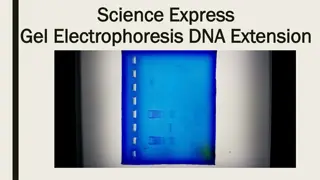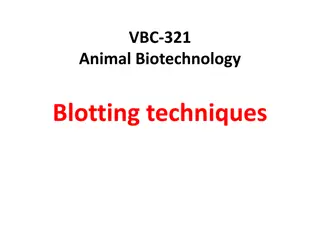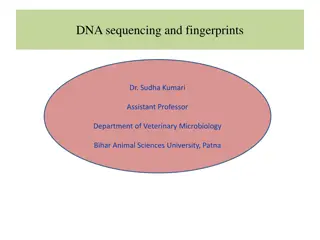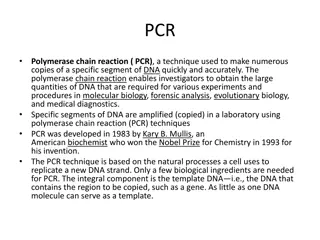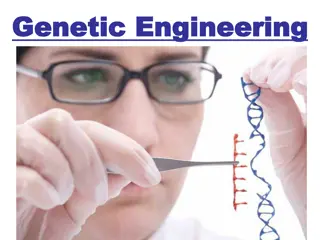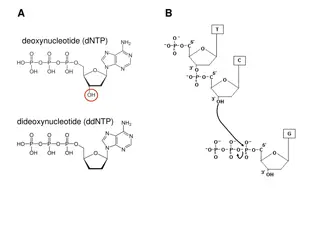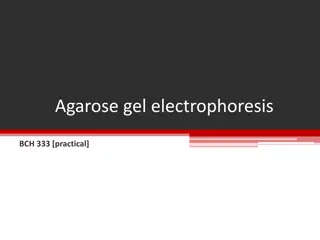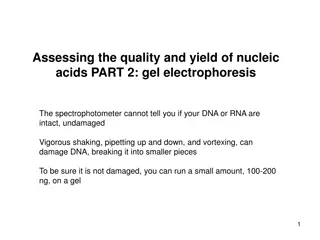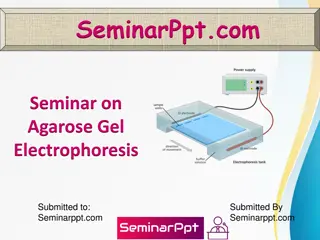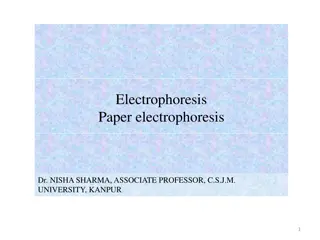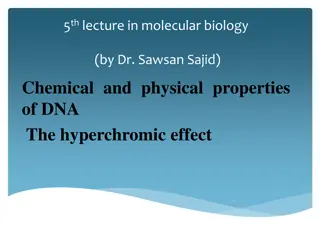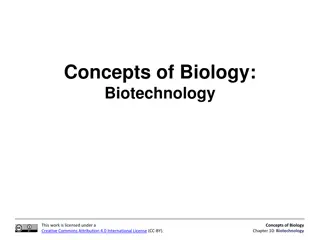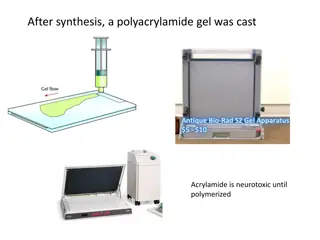Understanding Electrophoresis: Principles, Techniques, and Applications
Electrophoresis is a technique dating back to principles of electrochemistry, involving the movement of charged particles in an electric field for separation. Factors affecting electrophoretic mobility include charge, particle size, shape, and applied electrical field. Techniques such as paper, gel, and capillary electrophoresis are used for separating macromolecules like DNA, RNA, and proteins. The voltage applied affects the travel time of molecules being separated, with higher voltages leading to faster migration through the medium. Various factors like electrical force/unit charge, resistance, and voltage influence the migration rate of particles in electrophoresis.
Download Presentation

Please find below an Image/Link to download the presentation.
The content on the website is provided AS IS for your information and personal use only. It may not be sold, licensed, or shared on other websites without obtaining consent from the author. Download presentation by click this link. If you encounter any issues during the download, it is possible that the publisher has removed the file from their server.
E N D
Presentation Transcript
Electrophoresis Introduction, factors affecting electrophoretic mobility, Techniques of paper, gel, capillary electrophoresis, applications Dr. NISHA SHARMA, UNIVERSITY INSTITUTE OF PHARMACY C.S.J.M. UNIVERSITY, KANPUR nishasharma@csjmu.ac.in 1
INTRODUCTION Electrophoresis: dates back to Principles of electrochemistry- Hittorf, Nernst, Kohlrausch - property & nature of small ions in a solution under electrical field Arne Tiselius 1931 It is running in electrical field To bear electrons- motion of dispersed particles relative to a fluid under influence of spatially uniform electric field. Physical method of separation Charged particles migrated- solution- external electrical field 2
INTRODUCTION Electrophoresis of positively charged particles (cations) - cataphoresis, negatively charged particles (anions) called anaphoresis. Two Electrodes- ions for separation suspended - start moving to electrode of opposite charges- gets separated observed for the first time in 1807 by Russian professors Peter Ivanovich Strakhov and Ferdinand Frederic Reuss at Moscow University. Clay particles in water- migration- electrical field Used for macromolecules- DNA, RNA, Proteins 3
FACTORS AFFECTING Nature of sample i.e. Charge on particle: Net charge on particle , Rate of migration Size of particle: Rate of migration , Size is Shape of particle: particles with same charge but varied shape- Rate of migration varies 4
FACTORS AFFECTING Applied electrical field : EF: property describing the space surrounding electrically charged particles. Electrical Force/unit charge. EF- exerts force on other charged objects, & is radially outward from a +ve charge, and inward toward ve charge. Movement of ions depends on I,V, R Ohms law I=V/R (Current = voltage / resistance) Current: in C, ses V, hence Rate of migration Voltage: in V, Rate of migration Resistance: Rate of migration with R Motion by electrophoresis of a charged particle 5
Applied electrical field VOLTAGE: Affects the Travel time of the molecules being separated. The higher the voltage, the faster sample will travel through the gel But very high voltages may melt the gel or cause smearing or distortion of bands. If the separation of the electrodes is d (meters) and the potential difference between them is V (volts), the potential gradient is V/d volts m-1. If force on the ion with a charge is q (coulombs), equation is Vq/d newtons, The rate of migration is proportional to Vq/d, so it increases with increase in potential difference. Voltage is the potential energy of electrical supply stored in the form of electrical charge. 6
Applied electrical field Current Current is generated due to potential difference applied between the electrodes. It is a continuous and uniform flow of electrons around a circuit that are being pushed by the voltage source. Current is measured in coulombs sec-1. The current is mainly conducted between the electrodes by buffer ions. Thus, increase in voltage will increase total number of charge towards the electrode. The distance traveled by the ions is directly proportional to the current and the time. 7
Applied electrical field Resistance: property of measuring the resistance to the flow of an electrical current. Resistance of an electrophoresis unit depends on size, gel thickness, amount of buffer, buffer conductivity, & temp. This resistance normally ses in time with sing temp. The rate of migration of ions is inversely proportional to resistance as per ohms law. Resistance ses with length of supporting medium but ses with its cross-sectional area and with se in the buffer ion conc. The power dissipated in the supporting medium, W (measured in watts) during electrophoresis is W= I2/R An sein Temp leads to se in resistance. This is due to sed mobility of ions and evaporation of the solvents from the supporting medium. 8
FACTORS AFFECTING Nature of supporting medium: Buffer It stabilizes and fixes pH of supporting medium, affecting Rate of migration Ionic strength: As ionic Strength buffer ses, C carried by buffer ses, proportion of C carried by sample ses, & hence Rate of migration of sample ses High ionic strength ses overall C, hence heat is produced As Strength of ionic Buffer , C carried by buffer ses & proportion of C carried by sample ses, hence Rate of migration of sample ses Low ionic strength overall se in C, hence se in heat prod. Ionization vs pH: Organic acids: pH ses ionization & vice versa. Degree of ionization depends on pH 9
FACTORS AFFECTING Supporting medium In solution : Rate of migration is In stabilizing med. Rate of migration is Supporting medium - inert preference Selected medium based on adsorption / molecular sieving / electro-osmosis- affects electrophoretic speed Adsorption: means retention of sample by supporting medium. Adsorption causes tailing of sample Adsorption reduces both Rate of migration & resolution of molecule 10
FACTORS AFFECTING Molecular sieving: depends on Type of gel Gels have seive like structure In agar, starch, poly acryl amide gels the movement of large molecule is hindered by decreasing the pore size, because all the molecules have to travel thru pores In sephadex gel, small mol. are tightly held by pores & large mol. are excluded by small pores that causes movement outside the pores known as molecular seiving 11
FACTORS AFFECTING Electro-osmosis is relative charge b/w H2O mol. in buffer & surface of supporting medium Electro-endo osmosis: It is due to presence of charged groups on the surface of supporting medium Ex: Paper: COO-, Agarose- SO4-- Glass wool- Silanol SiO- Above pH of 3 , these charged groups will ionize & generate negatively charged sites. 12
FACTORS AFFECTING The ionized groups create an electrical double layer or region at supporting medium when V is applied, it causes the cation in electrolyte near supporting medium migrate towards cathode pulling the electrolyte solution with them, creating a net electro endo osmotic flow towards cathode. The Electro-endo osmosis accelerates the movement of cations but decreases movement of anions 13
Principle of Electrophoesis Method to separate charged particles from one another based on differences in their migration speed. 2 electrodes (typically made of an inert metal, e.g. platinum) are immersed in two separate buffer chambers. 2 chambers are not fully isolated from each other Charged particles can migrate from one chamber to the other By using an electric power supply, electric potential (E) is generated between the two electrodes. 14
Principle of Electrophoesis Due to the electric potential, electrons move by a wire between the two electrodes. electrons move from the anode to the cathode. the anode will be positively charged, while the cathode will be negatively charged Electrons driven to the cathode will leave the electrode and participate in a reduction reaction with water generating hydrogen gas and hydroxide ions. In the meantime, at the positive anode an oxidation reaction occurs. Electrons released from water molecules enter the electrode generating oxygen gas and free protons (which immediately form hydroxonium ions with water molecules). 15
Principle of Electrophoesis The amount of electrons leaving the cathode equals the amount of electrons entering the cathode. As the two buffer chambers are interconnected such that charged particles can migrate between the two chambers. These particles are driven by the electric potential between the two electrodes. Negatively charged ions, called anions, move towards the positively charged anode, while positively charged ions, called cations, move towards the negatively charged cathode. 16
Principle of Electrophoresis An electric force Feis exerted on the charged particle. The magnitude of the electric force equals the product of the charge q of the particle and the electric field E generated between the two electrodes: Fe = q x E (dimension of E= N/C or V/cm) As soon as the electric field is applied and the charged particles are accelerated by the electric force, a drag force (Fd) called friction will also be immediately exerted on the particles by the medium. Direction of Fd is opposite to the direction of particle movement, is proportional to the velocity of the particle. 18
Principle of Electrophoresis At the typically very low speed of particle migration during electrophoresis, the force Fdis a linear function of the velocity (v) of the particle, as Fd = f x v Frictional coefficient (f): ratio of the force and the velocity The value of f is a function of the size and shape of the particle and the viscosity of the medium. The larger the particle and the more obstructing the medium, the higher the value of f 19
Principle of Electrophoresis When electrophoresis is started, particles accelerate instantaneously to a velocity (v) at which the magnitude of the drag force equals the magnitude of the (opposite) accelerating electric force: Fe=Fd q x E = f x v Once the magnitude of the two opposing forces becomes equal, the resultant force becomes zero. Therefore, each particle will move at a constant velocity characteristic of the given particle at the given accelerating potential and medium. 20
Principle of Electrophoresis The electrophoretic mobility ( ) of the particle, defines the velocity of the particle in a given medium when one unit of electric field is applied. is a linear function of the charge of the particle and it is a reciprocal function of the frictional coefficient (which depends on both the size of the particle and the nature of the medium): Particles having different electrophoretic mobility, i.e. those that migrate at different speeds in the same medium and electric field, can be separated by electrophoresis. 21
Migration of charged particles on supporting media Migration of charged particles in solution. No supporting media TYPES OF ELECTROPHORESIS Zone Moving Boundary Electrophoresis Electrophoresis Isoelectric Cellulose Acetate E Iso tacho- phoresis Capillary E Paper E Gel E Immuno E Focussing 22




